S <===
BAXTER ST / CENTRE MARKET PL
===> N
South:
181-187: This compact
three-story
building, painted red with green trim, closely
resembles its four neighbors
to the east, including the Banca Stabile
building on the corner. Houses Dolce Vita
Restaurant.
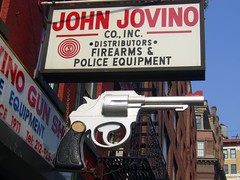
183: John Jovino Gun Shop, opened 1911,
is the oldest gun store in New York City; it's the
sole survivor of a gun district near the Centre Street
police headquarters. A
2003 study found that
nearly 1 percent of traceable guns used in New York
City crimes can from this shop.
185-189 (corner):
Banca Stabile, a bank
operated by the Stabile family, operated out of 189 from
1882 until 1932, serving as the neighborhood's
financial center. It was something of a time capsule
until 2008, when it became home to a museum of
Italian immigration.
|
|
|
North:
174 (corner):
Onieal's, longrunning eatery that dates
back at least to 1909, when it was a speakeasy, gambling
den and brothel connected via secret tunnel
to police headquarters. (The tunnel now serves
as a wine cellar.) Onieal's appeared as the Scout
Bar on Sex and the City.
176-178:
Lendy Electric Equipment & Supply; Agrest & Gandelsonas Architects
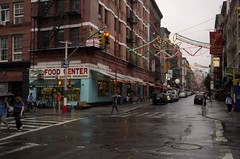
161 (corner): Salumeria Italian Food Center
|
|
South:

191 (corner): Rossi Imports
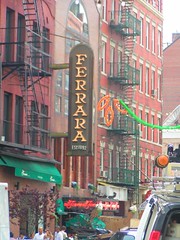
195: Legendary pastry shop
opened in 1892 and now run by
Antonio Ferrara's great-grandnephews.
They say the secret of their shop's
success is frequent baking. Enrico
Caruso is said to have been a fan.
203 (corner): Twins 99 Cents Plus,
Manhattan Grand Optical are in a building
with a
beautiful entrance.
|
|
|
North:

188 (corner): Alleva, opened in
1897, is said to be the oldest cheesemaker in the
U.S.--specializing in ricotta and mozzarella.
192: Florio's Restaurant; 3 Little Indians
194: Nyonya
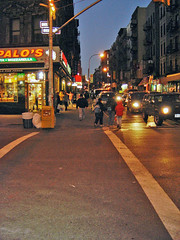
200 (corner): Di Palo's Fine Imported Italian Cheese.
Also in this building was Pearl River Emporium--not the
famous one.
|
|
South:
209: B&J USA Trading Inc.
211: Kwamwo Herbal Pharmacy
213: 213 Grand Street Gourmet Restaurant
215: Bogdanow Partners Architects
217: Grand Manna Bakery
219 (corner): Wing Fat Company Inc.
is in a handsome five-story
red-brick building.
When Grand Brass Lamp Parts Inc. was at
this corner, until 2004, it was numbered 221.
|
|
|
North:

206 (corner): Yue Fung Enterprises;
Yong Qiang Fashions
208: Mon Fung Co.
210: Kwong Wah Cake Co.
212: Food Street; Mon Wong Restaurant
214: Good Dumpling House was Fay Da Bakery.
218 (corner): Good Taste Villa
|
|
South:
229: M. Kessler Hardware
is in a five-story building with
an
interesting Gothic window design
on the top floor.
231 (corner):
An existing office building was expanded to
make this franchise branch in 2007.
It's owned by the Wok & Roll restaurant group,
which is also building the Comfort Inn on
Chrystie Street.
|
|
|
North:
Bowery Savings Bank
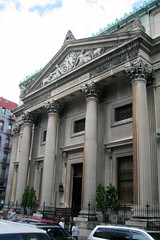
Corner: This 1894 landmark was designed
by Stanford White; it's thought to have started the
fashion for banks that look like Roman temples.
It replaced the original Bowery Savings Bank,
built here in 1834.
Now houses
Capitale, an event space with 75-foot
ceilings.
230 (corner):
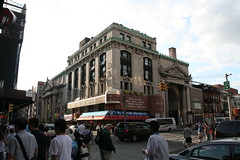
This building was built in 1902 as the Bowery Bank.
You might confuse it with the similarly
named Bowery Savings Bank, which wraps around
it in an L shape. Among other businesses, it houses
Tung Woo tofu, Double Crispy Bakery and
Tu Quynh Pharmacy, recently a Citibank branch.
|
|
S <===
THE BOWERY
===> N
The traditional border between Little Italy and the Lower East Side
|
South:

237 (corner):
Grand Street Optical,
Quickly Shabu Shabu (soup cooked at your table), Grand City. This corner
used to be Moisha's Luncheonette. On the Bowery side of the
building is the entrance to the Providence Hotel, a flophouse
that dates back to 1895.
239: Grand City
241: Bor Kee Food Market. This and
239 are part of the same building at 237.
243: Grand Sanky Bakery

245: Nam Son, Vietnamese (was Pho Tuong Lai Restaurant?)
247: Ken Hing Food Market, Vietnamese
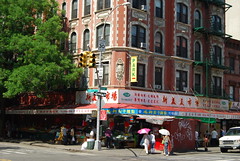
249-253 (corner): The Hai Sein, Tan My My Market
|
|
|
North:
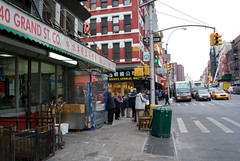
Corner (240 Grand): Kong Kee Food Corp.--tofu, soy milk etc.--was
Winner Coffee.
246: New Wing Wah Bakery moved
here from 244 next door.
248: Chinese Evangelical Mission Church
(was Grand Station Noodles?)

250 (corner): Ocean Star Seafood Market
|
|
South:
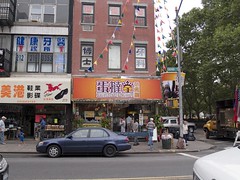
271 (corner): Egg Custard King Cafe was
Hing Wong House
273: Guan's International Trading
275: Wing Wong Variety Store
277:
Pho Grand, Vietnamese; formerly Grand Seafood
281: Lucky Food Market
283: UT Trading was Fabricworld
|
|
|
North:
272 (corner):
Fairtown Trading Inc., Grand China Meat Market.
Was Penchina Textile Corp, wholesale dry goods distributor,
until 1993.
276: U-2 Video Depot
278: Metro Video
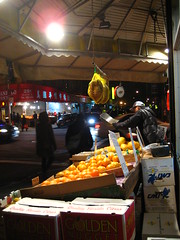
280:
Lucky King Bakery was Fortune Stars Bakery
286: Tai Jiang Market
|
|
South:
291 (corner):
HK Manpolo Market; Higher Learning on 2nd floor
295: Grand Bakery,
fried chicken and baked goods, was CAB Seafood Restaurant
297: Beijing Co.
299: C.T.C. Shoes
303: Tai Cheung Kitchen Supply
305: Maxime Furniture
|
|
|
North:
290 (corner): Lok Sing Chinese Restaurant
292: Hong Kong Furniture
294: M&A Decorators, M. Karfiol & Son
298: Chinatown TV is with 300 a
two-story
building with dormer windows.
300: Hong Wong Restaurant was MK Chinese Restaurant
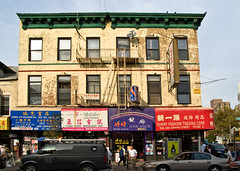
302-306 (corner): Grand Home Center;
Rui Hui Books; Sunny Fashion Trading
|
|
South:
Corner (62-70 Allen): This building, an 1876 French Empire
structure, was E. Ridley
& Son, which claimed in 1886 to be the country's
largest retail store, when
Grand Street east of the Bowery was the place to go for women's
fashions. Founded as a small dry goods store in
1850, Ridley's moved uptown in 1901, and a fire badly damaged this
building in 1905; one side was removed for the
1932 widening of Allen Street.
On November 23, 1859, No. 70, the corner address, was the birthplace
of Henry McCarty--better known as
Billy the Kid. McCarty moved west with his family in 1865, where he later
killed 21 men under the name William Bonney.
315: Rococo Products
317: Elegant Home; Good Locksmith Inc.

319-321 (corner): Modern Decor and Jodamo
Hi-Fashion Men's Clothing is in another part of
the former E.S. Ridley Department Store,
built c. 1870. It left here in 1901,
but in 1964 a letter was delivered to this address,
complaining that the Ridley's catalog had not been
delivered "for some time."
|
|
|
North:
314: Fishkin Knitwear
Corner: Zahir Fabrics
|
|
South:
323 (corner): Manhattan Chinese
Cultural Services (MCCS) Day School; was Rice
& Breskin clothing.
Describing the style
of the romance magazines at which he learned
his trade, science fiction writer
A.E. Van Vogt
said: "You don't say, 'I lived at 323 Grand Sreet.'
You say something like 'Tears came to my eyes as I
thought of my little room at 323 Grand Street.'"
325: Was Friedman Hosiery
327: Espy Display was Montgomery Stationery
329: Teng Fei Grocery was Amy's Grocery
333: DigitMine Computer
335: Eastern Super Market
337: Fortune Home

339 (corner): Ideal Hosiery
has been run by the same family since 1950.
|
|
|
North:
322 (corner): Vogue Beauty Spa
324: At Home Concepts
328: Mawin Furniture
330: Grand Lingerie
332: Sultan Bras & Girdles
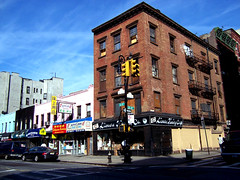
334 (corner): Was Lismore Hosiery.
The original four-story building here
had
three stories added in 2008.
|
|
South:
Corner (56 Ludlow): Lou Reed and John Cale
lived together in a loft here in 1965,
when they were forming the Velvet Underground.
345: Grand Sterling Silver Co.
349: Peter's Japanese Restaurant
351: Dragon's photo lab
353: Golden Forest Restaurant, Chinese
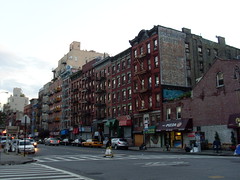
355 (corner): Flowers cafe has benches
outside labeled "for our customers and the elderly."
|
|
|
North:
Seward Park High School
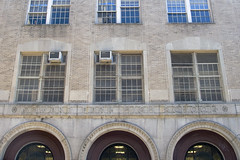
350 (block): The school was built on the site
of the Ludlow Street Jail. Victoria Woodhull,
who in 1872 became the first woman to run
for president, was jailed here that Election
Day for publishing an account of
Rev. Henry Ward Beecher's affair with a parishioner.
(As a woman, she would not have been allowed to
vote anyway.) This jail was also home to William
Marcy "Boss" Tweed, after he was convicted of
misappropriation of funds in 1873. Though he escaped to
Spain at one point, he was brought back and
eventually died here on April 12,
1878.
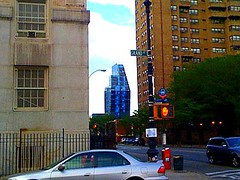
The school dates back to 1929; famous
grads include Walter Matthau, Tony Curtis,
Zero Mostel, Jerry Stiller and
the songwriter
Sammy Cahn--not to mention both Julius
and Ethel Rosenberg. Today the
New Design High School, an art-oriented magnet
school, is on the fourth floor.
|
|
South:
357 (corner): Law & Tax Offices
359: Shalom Chai Pizza Falafel Ice Cream,
kosher dairy restaurant
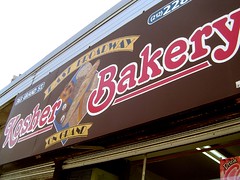
363: East Broadway Kosher Bakery
365: Isabella's Oven
Kossar's Bialys

367: Founded 1936. A bialy is something like
a holeless, oniony bagel--and these are widely considered the
best in the city.
377: Amity Studio Photo and Custom Frame
Doughnut Plant
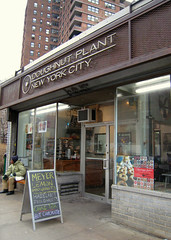
379: These are the best doughnuts on
the planet. It's not just me who says so--
Martha Stewart does too.
389: Grand Spa

393: Seward Park Liquors
399: Noah's Ark Original Deli
is a spinoff of a deli in Teaneck, N.J.

409 (corner): Congregation Emanu-El,
New York's first Reform congregation,
originally met for services on the second
floor of a building here from 1845-48. It's
now the address of Roots & Vines,
a cafe and wine bar.
|
|
|
North:
Block (56 Essex): Seward Park Community Center
|
|
Corner (50 Norfolk): Hong Ming Housing for the Elderly,
federally subsidized apartments sponsored by
the Chinese-American Planning Council; the
name means "good health." The 14-story building was
designed by Harold Edelman and built in 1982;
the Chinese characters on the building read
"Health Peace Quiet Serenity."
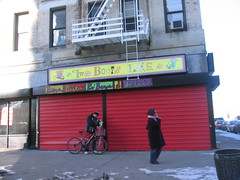
384 (corner):
Two Boots Tavern (formerly Two Boots LES), the southern
outpost of the local pizza chain whose name
evokes Italy and Louisiana--its culinary inspirations.
Also here is (or was?) the Grand Bakery.
|
|
South:
Seward Park Co-Ops
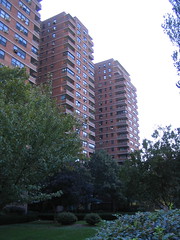
Part of
Co-Operative Village, these 12 towers
were designed by Herman Jessor and built from
1957-60. The Hatters and Painters unions' pension
funds helped pay for the development.
The complex features Socialist Realist-style
murals by
Hugo Gellert depicting
Jefferson,
Lincoln,
FDR and
Einstein, painted in 1959. In 1996,
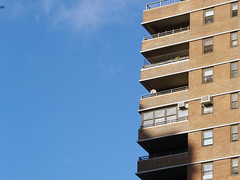 the co-op board tried
to have the historic murals removed, but they
reversed the decision after appeals from
art historians and union leaders.
the co-op board tried
to have the historic murals removed, but they
reversed the decision after appeals from
art historians and union leaders.
|
|
|
North:
410 (block): A 26-story building from 1972.
414: The Arbeter Ring, or
Workingmen's Circle, a socialist fraternal
order, held its first national
convention in a meeting hall here in 1901.
424: In the film Eternal Sunshine
of the Spotless Mind, this is the address
of Lacuna Ltd., the memory-erasing firm.
|
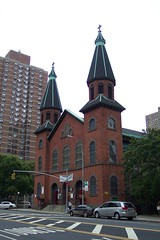
438 (corner): This is the third-oldest Catholic
parish in New York City, after St. Peter's and
Old St. Patrick's. Its first church,
a wood structure built in 1826 on Sheriff
Street, was burned by anti-immigrant arsonists;
this replacement, built of fieldstone,
reopened in 1833. (The red-brick Italianate
facade was added in 1871, designed by
prolific church architect Patrick Charles Keely.)
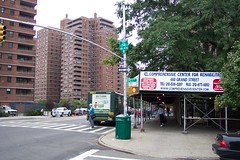
460 (corner): Compre-hensive Center for Rehab-ilitation
|
|
South:
Block (465 Grand): This
four-story building, which houses
an Emigrant Savings Bank branch, went up in 1963.
|
|
503 (corner): 99 Cent Plus Discount Store
505:
A 1 Pizza Shop
511: New Wing Hing Chinese Restaurant
is in a two-story
Federal-style rowhouse
with dormer windows built c. 1827; it was
landmarked in 2007.
513: A similar townhouse built
at the same time as 511.
515: LES Sushi
523: Hill Top Grocery Corp.
525: Pizza Shack
527:
People Choice Pharmacy
|
|
551 (corner): This triangular block
is the site of the
Ralph Lippman Auditorium,
a theater from the 1940s that is the new home
of the Paul Taylor Dance Company.
It's been
defaced some by the
Fine Fare supermarket on the ground floor.
557: Wa Lung Kitchen

565 (corner): Grand Express Deli,
formerly American Flagg Deli, aka Cozy Corner
|
|
|
North:
Abrons Arts Center
466 (block):

This arc-shaped complex was built in 1975
to provide the community with art facilities,
including spaces for dance, music, drama
and visual arts. Lo-Yi Chan was the chief
architect on the project.
The center was built around the
Harry De Jur Playhouse, established in
1915 as the Grand Street Playhouse
and later known as the Neighborhood
Playhouse. Founded by sisters Alice
and Irene Lewisohn, who directed community
drama clubs for the Henry Street Settlement,
the theater was designed by Harry C. Ingalls
and F. Burral Hoffman Jr., who based the
Colonial Revival plan on their own Little
Theatre (now the Helen Hayes) on 44th Street,
which went up in 1912.
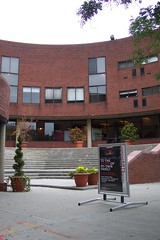
The theater showcased experimental
drama and featured new work by Eugene O'Neill,
George Bernard Shaw and James Joyce; Stravinsky's
Petrouchka, a ballet with life-sized puppets,
had its U.S. debut here in 1916. After the
Neighborhood Playhouse moved out of the
neighborhood (to the Little Theatre, its
original home's architectural model), serious
drama continued here, notably Aaron Copeland's
opera The Second Hurricane, which
premiered here in 1938 in a production
directed by Orson Welles and starring Eartha Kitt.
The Folksbiene Yiddish theater company also
got its start here.
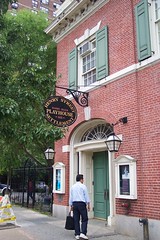
This stage has featured the likes of
James Cagney, Ethel Barrymore, Isadora
Duncan, Martha Graham, Count Basie and
Dizzy Gillespie.
Aline Bernstein, a
founder of the Met's Costume Institute,
began her career in costumes here--and
began her eight-year affair with novelist
Thomas Wolfe on a couch backstage.
|
Hillman Housing
500 (corner): Part of the Co-Operative Village
neighborhood, these buildings went up from 1947-50,
sponsored by the Amalgamated Clothing Workers of America,
whose president was Stanley Hillman. They were designed by
Herman Jessor of Springsteen & Goldhammer.
This unit is named
for Edward Filene, founder of the credit union movement.
Zafis Luncheonette and East Side Glatt are
on the Grand Avenue side.
Amalgamated Dwellings

504 (corner): The oldest project in
Co-Operative Village, this Art Deco
apartment building were built in 1930
by the Amalgamated Clothing Workers of America,
designed by Springsteen & Goldhammer to
give direct sunlight to each of the 236 units.
They were built on
the site of the most violent anti-Semitic riot
in U.S. history. In 1902, workers at the R. Hoe
and Co. printing press here threw bits of iron
and wood down on the 50,000 mourners in the
funeral procession of Chief Rabbi Jacob Joseph.
The Jewish mourners started throwing the
debris back; when police arrived, they sided
with the largely Irish workers and attacked
the Jews, some 300 of whom were injured.
An inquiry ordered by Mayor Seth Low
criticized police anti-Semitism.
The building served as the exterior
of the Lacuna company in the film Eternal
Sunshine of the Spotless Mind.
|
Hillman Housing

530 (corner): Another unit of Hillman Housing,
this one named for
Meyer London, a Socialist who
represented the Lower East Side in Congress. He opposed
World War I and was a critic of Zionism.
550 (corner): This Hillman house is named
for
Louis Brandeis, the first Jewish justice of the
Supreme Court, who advocated for the right to privacy
and freedom of speech.
|
East River Houses
The furthest east section of Co-Operative Village,
these were built in 1956 to a design by Herman Jessor,
described by the AIA Guide as "carven brick
monoliths." (They mean that as a compliment.)
They
were originally named the Corlear's Hook Houses,
after a peninsula near here that was a fishing spot
known to the Lenape Indians as Nechtanc ("Sandy Point").
It became the farm of Jacob von Curler, who gave his
name (sort of) to the area. It w
|
|
East River Park
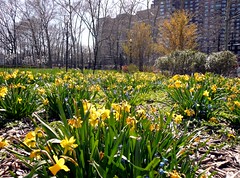
Robert Moses built this park on landfill and
former docks in the 1930s, during the
construction of the FDR Drive.
|
|
